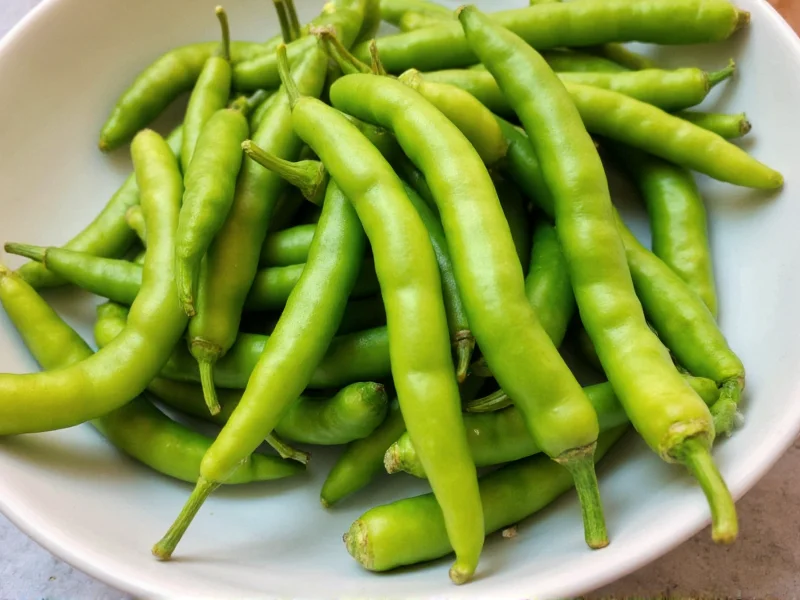When exploring mild chile pepper varieties, understanding heat levels is essential for successful cooking. Unlike their fiery counterparts, mild chiles deliver complex flavors without overwhelming heat, opening culinary possibilities for home cooks of all experience levels. This guide examines the most accessible mild options, their unique characteristics, and practical applications in everyday cooking.
Understanding Chile Heat Measurement
The Scoville scale measures chili pepper heat by determining capsaicin concentration. Mild chiles register below 1,000 Scoville Heat Units (SHU), with many popular varieties falling between 100-500 SHU. For context, bell peppers measure 0 SHU while jalapeños range from 2,500-8,000 SHU. This significant difference explains why best mild chiles for beginners rarely cause discomfort while still contributing distinctive flavor profiles.
Top Mild Chile Varieties Compared
| Chile Variety | Scoville Range | Flavor Profile | Best Culinary Uses |
|---|---|---|---|
| Poblano | 1,000-2,000 | Earthy, slightly sweet, grassy | Chiles rellenos, mole sauce, roasted dishes |
| Anaheim | 500-2,500 | Fruity, tangy, mild bitterness | Stuffed peppers, green chile stew, roasted salsas |
| Cubanelle | 100-1,000 | Sweet, light pepper flavor | Stir-fries, sandwiches, pickling |
| Banana Pepper | 0-500 | Sweet, slightly tangy | Pickled preparations, salads, sandwiches |
| Guernsey Pepper | 0-200 | Very sweet, minimal heat | Raw applications, salads, garnishes |
Detailed Profiles of Common Mild Chiles
Poblano Peppers
Often mistaken for mild chiles due to their dark green color, poblanos actually sit at the upper threshold of mild heat. When roasted, they develop a rich, earthy flavor perfect for mild chile recipes like chiles rellenos. Fresh poblanos work well in salsas verde, while dried versions (called ancho chiles) contribute deep flavor to mole sauces without excessive heat.
Anaheim Peppers
These long, tapered peppers offer consistent mild heat with subtle fruitiness. Home gardeners favor Anaheim peppers for their reliability and versatility. When selecting low heat chili peppers for family meals, Anaheims provide just enough warmth to interest adult palates while remaining accessible to children. Roasted and peeled, they form the base of traditional New Mexican green chile stew.
Cubanelle and Banana Peppers
True mild options, these sweet peppers rarely exceed 500 SHU. Cubanelles feature thin walls ideal for quick cooking, while banana peppers offer distinctive curved shapes and bright yellow color. Both excel in mild chile substitutes when bell peppers lack sufficient flavor complexity. Their thin walls make them perfect for quick-pickling or adding raw to sandwiches and salads.
Practical Cooking Applications
Understanding mild chile heat levels helps determine appropriate usage. For beginners, start with these applications:
- Roasting technique: Char skins over open flame or under broiler, then steam in paper bag for 10 minutes before peeling. This enhances sweetness in poblano and Anaheim varieties.
- Substitution guide: Replace bell peppers with Cubanelles for added flavor without heat, or use roasted Anaheims instead of jalapeños in salsas for family-friendly versions.
- Storage methods: Freeze roasted, peeled mild chiles in airtight containers for up to 6 months. Fresh peppers last 1-2 weeks refrigerated in crisper drawer.
Common Mistakes to Avoid
Even mild chiles require proper handling. Many home cooks make these errors:
- Assuming all green peppers are mild (some varieties like serranos are hot despite green color)
- Not removing seeds and membranes (where most capsaicin concentrates, even in mild varieties)
- Overcooking, which diminishes delicate flavors
- Misidentifying similar-looking varieties (poblanos vs. pasillas)
Expanding Your Mild Chile Experience
As your palate develops, experiment with these techniques to maximize flavor from non-spicy chili pepper options:
- Combine different mild varieties in the same dish for layered flavor
- Add acidic components like lime juice to balance earthy notes
- Pair with complementary ingredients: chocolate with poblanos, citrus with Anaheims
- Try smoked versions (like chipotle's milder cousin, morita) for depth without heat
When Mild Isn't Mild Enough
Occasionally, even mild chiles may prove too spicy for sensitive palates. In these cases:
- Soak sliced peppers in salted water for 15-20 minutes before cooking
- Add dairy components like cheese or yogurt to neutralize capsaicin
- Use only the outer flesh, completely removing seeds and inner membranes
- Consider bell peppers as the ultimate mild chile substitute when zero heat is required











 浙公网安备
33010002000092号
浙公网安备
33010002000092号 浙B2-20120091-4
浙B2-20120091-4